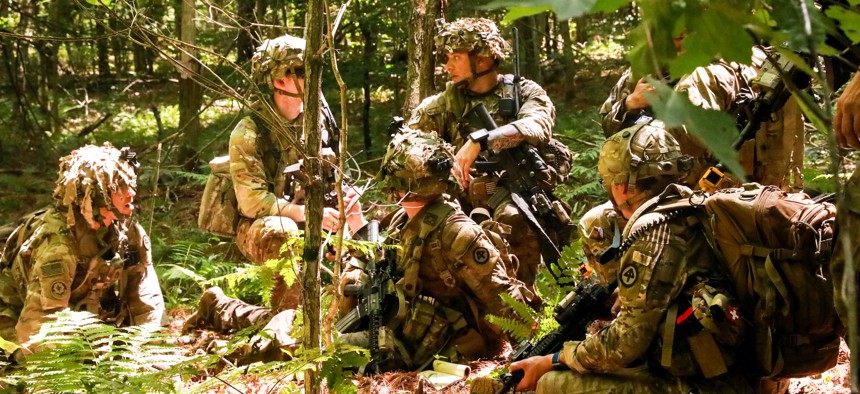
U.S. Army Soldiers assigned to Charlie Company, 1st Battalion, 181st Infantry Regiment, 44th Infantry Brigade Combat Team (IBCT), Massachusetts Army National Guard, conduct combat training exercises during the eXportable Combat Training Capability (XCTC) exercise on July 19, 2022 at Ft. Drum, N.Y. U.S. Army / Pfc. Seth Cohen
The Army Brief: The force is shrinking; Military life palls; Infrastructure warning; and more…
Welcome to The Army Brief, a weekly look at the news and ideas shaping the service’s future.
The Army is shrinking faster than planned. Just months ago, service leaders filed a 2023 budget request that proposed to shrink the service by 12,000 troops to 473,000. Now they foresee the force declining to 466,000 soldiers by year’s end, Defense One's Elizabeth Howe writes. That’s because of the “most challenging recruiting environment since the All-Volunteer Force was established in 1973,” according to an Army memo released Wednesday. What’s next? The Army is relaxing more policies and reintroducing old incentives as part of its continued efforts to increase recruiting. Read on, here.
Fewer military families would recommend military life. According to a 2021 survey just released by the Military Family Advisory Network, which conducts research on issues affecting military families, just 62.9 percent of military and veteran families would recommend military life, down from 74.5 percent in 2019. “When we’re going through this report and seeing some of the findings and the reality that a lot of families are having a hard time making ends meet, it’s not all that startling to see that there will be a decline here,” said president Shannon Razsadin. “But what I was really surprised by was, you know, that it was as big of a decline as it is.” More, here.
A flood-control project nears its finish. A project to keep rising seas from inundating Norfolk Naval Base will be complete this summer, but it’s a fraction of the work needed to reduce the effects of climate change on U.S. military infrastructure, including Army bases. The Norfolk project will take about 10 years from conception to completion, and it’s past time to get to work on the rest, writes John Conger, a former Pentagon comptroller and assistant defense secretary for installations. Read that, here.
Sign up to get The Army Brief every Friday morning from Caitlin M. Kenney, Defense One’s military services reporter. Bradley Peniston, Defense One's deputy editor, is filling in this week while Caitlin is on assignment. On July 22, 1943, Gen. George Patton and the U.S. 7th Army captured Palermo, Sicily.
 From Defense One
From Defense One
Army Outlines Plan to Overcome 'Most Challenging' Recruiting Era Since 1973 // Elizabeth Howe
The service has already shrunk below the reduced end-strength goal it set with its 2023 budget request.
Fewer Military Families Would Recommend Uniformed Service, Survey Finds // Caitlin M. Kenney
The Military Family Advisory Network poll may have warning signs for recruiters.
At UK Airshow, Defense Execs Warn of Inflation, Supply Chains, and Worker Shortages // Marcus Weisgerber and Bradley Peniston
The Biden administration needs to invest in apprentice schools, CEO of top aerospace and defense firm says.
A Success in Norfolk Should Also Be a Warning // John Conger
One flood-control project took a decade to complete. Lawmakers and feds can't wait any longer to get the vast bulk of climate-mitigation work going.




